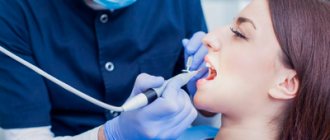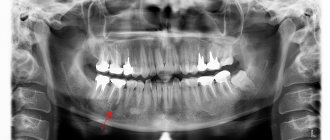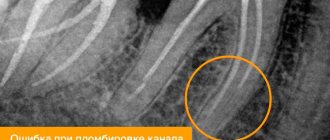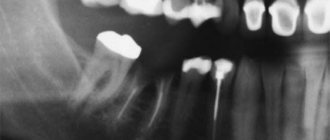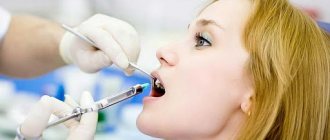31.10.2019
Most often, pain relief and tooth extraction during breastfeeding are a necessary measure. Pregnant women and nursing mothers are not recommended to undergo this operation. If the need for removal does arise, it is important to take precautions.
Indications for tooth extraction during lactation
If acute pain occurs in the maxillofacial area, you should contact your dentist. Pain can be a signal of a purulent inflammatory process:
- periostitis;
- abscess;
- suppuration of the cyst.
These diseases occur extremely rarely in a sanitized oral cavity, but still no one is immune from this, even nursing mothers.
During pregnancy and after the birth of the baby, the mother bears double responsibility - for the health of the child and for her own. During lactation, a woman has a close relationship with her baby, and if there is a focus of the disease, the mother can transmit the infection to the child. In addition, the disease can lead to psycho-emotional stress and cause loss of milk.
Indications for tooth extraction are:
- chronic periodontitis in the acute stage;
- mobility 3-4 degrees;
- odontogenic osteomyelitis;
- periostitis;
- odontogenic sinusitis, phlegmon, abscess;
- periodontitis;
- periodontal disease;
- incorrect tooth position or lack of space;
- tooth root fracture.
Relative contraindications to surgery are:
- angina;
- stomatitis;
- gingivitis;
- conditions of the body that need to be normalized (psychosis, hypertension, ARVI, coronary heart disease).
Absolute contraindications are serious diseases of the body that require urgent intensive care:
- heart attack;
- arrhythmia;
- endocarditis;
- leukemia;
- acute liver or kidney failure; acute infectious diseases.
My wisdom tooth hurts, what should I do?
According to statistics, it is wisdom teeth that most often cause problems.
Erupted “eights” are quickly affected by caries, and sometimes even remain in the bone tissue and in most cases cause discomfort. So what to do with a wisdom tooth when it hurts, haunting you day and night?
What is known about wisdom teeth?
They got their name because they begin to erupt between the ages of 18 and 30. Scientists consider them to be a vestigial organ that does not bear any functional load when chewing food for years. Therefore, at present, some people do not develop “eights” at all.
Their medical name is third molars. These teeth were originally designed for chewing rough food. This determines their specific structure (large root base, width) and strength.
But this is also the main root cause of painful processes during growth, because the larger the area of the upper edge, the more difficult it is to tear the soft tissues and pass through them. Moreover, the bone tissue has already been formed, so the “eights” need to literally break their way, which leads to the formation of edema, suppuration, tumors and other unpleasant consequences.
Typically, discomfort is caused by recumbent “eights”, which grow horizontally in the jaw. They don't have enough space to erupt and put pressure on neighboring teeth. As a result, the entire dentition shifts. Moreover, recumbent “eights” severely injure the gums, which leads to chronic inflammation.
Signs of wisdom teeth erupting
- Pain in the jaw, radiating to the ears and temples
- Inflammation, swelling and itching of the gums behind the last tooth
- Enlarged lymph nodes
- Temperature increase
- Painful swallowing
- Persistent runny nose
- Difficulty opening your mouth
- Halitosis, that is, bad breath.
The presence and nature of symptoms depends on the individual characteristics of the body. There are cases when a person does not experience discomfort or pain at all when teething: this means that the “eight” is growing correctly and does not interfere with neighboring teeth. But it is still necessary to visit the dentist, since the formation of pathology can occur in a hidden form.
What types of wisdom teeth are there? For “eights” that have difficulty erupting, there are special terms in dentistry - “dystopic” and “retained”.
Dystopic teeth are those that grow incorrectly due to lack of space in the jaw. Usually they are shifted towards the tongue, cheeks or located at an angle. Impacted teeth are unerupted teeth that remain completely in the bone. There may also be a state of semi-retention, when the tooth appears, but cannot fully erupt.
Why do wisdom teeth hurt and gums become inflamed?
Most often, pain occurs due to difficult eruption for several reasons.
- Dystopia. This is a situation where the figure eight grows incorrectly relative to the jaw due to lack of space. Trauma to the buccal mucosa, as well as the development of various bite deformities, can be the consequences of a dystopic tooth if it is not removed in time.
- Retention. This is a pathology in which the wisdom tooth erupts with a delay. In this case, the crown of the tooth can be partially cut through or completely hidden under the gum. Late eruption of the figure eight can negatively affect the patient’s general well-being.
- Pericoronitis. This is an inflammation of the gums that occurs when tooth eruption is difficult or incomplete. The reason for this is the development of infection under the hood of the wisdom tooth - this is the part of the mucous membrane that covers the tooth during eruption. The main symptoms of pericoronatitis are pain, swelling and redness of the gums.
- Caries and its complications (pulpitis, periodontitis). It is quite difficult to qualitatively remove plaque from the surface of a wisdom tooth, since the “figure eight” is located far away. As a result, caries occurs. Progressing over time, it can destroy the tooth quite severely and cause pain.
What to do if your wisdom tooth hurts?
The first and most important rule is to make an appointment with a doctor! Only a doctor can assess the severity of the situation. After the examination, you will be given an x-ray and given options for solving the problem.
If a tooth erupts and your gums hurt, what should you do?
If this pain is periodic and rather discomforting, then you can massage the gums, treat them locally with antiseptics and anesthetic gels (they will be mentioned below). As a rule, this is enough to relieve discomfort before visiting a doctor.
But sometimes a gum hood forms; the gums become swollen, inflamed, and the pain becomes more severe. What to do at home:
- sign up for an appointment with the doctor
- take an anti-inflammatory pain reliever - for example Nimesil or Nurofen.
- Take frequent baths with warm soda or saline solution
- rinse your mouth with a decoction of chamomile, calendula or sage
- treat with chlorhexidine 0.05% or miramistin
- Apply ointment "Cholisal", "Rapid" or "Asepta"
It is important, do not neglect hygiene; carefully use a brush and irrigator to thoroughly clean the surfaces of adjacent teeth. The more plaque accumulates (i.e. a breeding ground for microorganisms), the greater the inflammation.
Treatment for inflammation of a wisdom tooth
Between the chewing surface of the tooth and the hood, favorable conditions are created for the proliferation of pathogenic bacteria and the gums become inflamed. For minor inflammation, as first aid, you can rinse your mouth with an antiseptic and apply bandages with anti-inflammatory gel. These measures must be combined with taking anti-inflammatory and painkillers, but under the supervision of a doctor.
With significant inflammation, symptoms such as discharge of pus, severe swelling of the gums and cheeks, pain when swallowing, and fever are observed. In this case, you should immediately consult a doctor to avoid complications. Treatment is carried out by a dental surgeon. It consists of excision (incision) of the hood under local anesthesia and medicinal treatment of surrounding tissues. As a result, the suppuration goes away. Afterwards, antiseptic rinses and anti-inflammatory gels are also prescribed, and antibacterial therapy may be prescribed.
However, most often “wisdom” teeth are removed, because scientists have already determined that they are a rudiment that does not help us chew food, but much more often creates problems.
Wisdom tooth removal
This is a very common procedure.
Most often, the operation takes place on an outpatient basis under local anesthesia. It is possible to perform removal under oxygen sedation with nitrous oxide to reduce anxiety or under medicated sleep conditions.
Before the removal procedure, a thorough diagnosis is carried out, and, if necessary, antibacterial therapy is prescribed.
The removal itself is painless, as it is carried out using painkillers. But in the process, soft tissues are injured, so after the removal of the wisdom tooth and the cessation of anesthesia, the patient experiences pain. After a few days, the swelling finally subsides and the pain subsides.
This is also facilitated by the prescription of antimicrobial drugs. After removal, the doctor gives recommendations on nutrition, lifestyle and hygiene for several weeks. Compliance with all medical recommendations will help to avoid the development of complications and speed up the recovery process.
If your wisdom tooth hurts during pregnancy or while breastfeeding, what should you do?
You should contact your dentist at the first discomfort. At home, while waiting for a visit to the doctor, you can resort to safe local measures:
- Take frequent baths with warm soda or saline solution
- rinse your mouth with a decoction of chamomile, calendula or sage
The remaining medications will be prescribed by the doctor after consultation and examination.
In most cases, it is possible to solve the problem using gentle therapeutic methods and avoid urgent wisdom tooth removal during pregnancy.
If possible, the surgical procedure is postponed to a later time. Its implementation is undesirable due to possible side effects (stress, fever, painful rehabilitation).
But the dentist always focuses on the condition of the teeth in a particular case. He will try to save the tooth and delay the surgical procedure if possible. However, in case of severe inflammation, for example during a purulent inflammatory process, removal will be carried out urgently, since this contributes to the spread of infection throughout the body.
The source of infection poses risks much higher than when using medications during removal. Therefore, it is very important to solve the problem in order to avoid complications for the mother and her baby.
When breastfeeding a baby, the mother must carefully monitor her own health. If there is an infection, it can be passed on to the child, since communication with him is very close.
In addition, a bad tooth causes stress and is physically exhausting, and this can have a bad effect on the quality and quantity of milk.
If your wisdom tooth hurts during breastfeeding, the first thing you should do is visit a dentist.
As with pregnancy, the need for extraction is determined only by a doctor after a thorough diagnosis. X-ray examinations can be safely performed during breastfeeding.
If it is possible to postpone the date of the operation, then extirpation is carried out closer to the end of breastfeeding, since after the procedure you may need drugs that can penetrate into mother's milk. However, if the situation is serious and requires emergency intervention, the doctor will decide to remove it.
The procedure for a woman during lactation is no different from that performed for ordinary patients.
For local anesthesia, drugs approved for pregnancy and lactation are used. They do not contain toxic components that can cause allergies and other side effects. The issue of feeding a child should be discussed with a doctor. Local anesthetics practically do not enter the blood, and components penetrate into mother's milk in minimal quantities.
If the doctor has not prescribed other medications, then you can feed the baby within a few hours. But if antibiotic therapy is necessary after a complex removal, then breastfeeding will have to be stopped for several days.
Anesthesia is used only in extreme cases, if a complex and lengthy extraction is being performed. If general anesthesia is necessary, the child is temporarily transferred to artificial nutrition. During this period, the mother must express milk regularly to ensure milk production continues.
Prevention measures
It is virtually impossible to change the atypical arrangement of 8s. But you can prevent the pain that occurs during eruption through routine removal. In this case, unexpected pain can be avoided, and, as a rule, healing in the absence of inflammation proceeds better and faster.
Particular attention should be paid to a comprehensive examination at the stage of planning a new addition to the family.
Based on x-rays, the doctor will be able to tell how the wisdom tooth will behave during pregnancy. When unfavorable factors are identified, it is easier to remove extra eights in advance.
Since teeth decay faster during pregnancy, it is necessary to carry out proper oral hygiene and undergo a preventive examination by a dentist while carrying a child.
Doctors’ recommendations for healthy teeth are very simple and known to everyone, you just need to follow them:
- brush your teeth twice a day;
- rinse your mouth after every meal
- use dental floss;
- eat well;
- limit consumption of sugary foods
- Get regular check-ups with a dentist
The most effective way to avoid trouble is to monitor the condition of your oral cavity and follow these simple and effective recommendations. Be healthy.
Preparation for surgical treatment
- Stages of tooth extraction in a nursing mother
- The procedure for tooth extraction in a nursing woman includes:
- taking anamnesis;
- determination of indications for surgery;
- preparing the patient;
- tooth extraction;
- postoperative period.
In 90% of cases, an X-ray examination is performed before surgery. The procedure is safe for nursing mothers, since the woman is wearing a lead apron through which radiation does not pass. But it is still advisable to express milk after the examination. Then you can feed the baby without fear.
Preparation consists of eliminating the fear of manipulation and the dentist; for this purpose it is not prohibited to use sedatives. After the operation, you cannot feed the child for 2 to 6 hours: this is the period required to remove the painkiller from the body. To provide the baby with nutrition during this time, it is worth expressing milk and feeding the baby more strongly before surgery.
Dry socket syndrome during wisdom teeth removal
Dry socket syndrome in wisdom teeth
The wisdom tooth refers to the concept of dry socket, or more precisely, dry socket syndrome. A dry tooth socket is alveolitis. Dry socket syndrome after the removal of figure eights can occur in this area, especially in the area of the lower wisdom teeth due to the fact that as a result of swallowing, as a result of opening the mouth, muscles tense, which aggravate the occurrence of alveolitis.
What can dry socket syndrome lead to and what to do?
A dry socket after the removal of figure eights can lead to very severe pain that radiates to the temple and ear. This is a very great torment: a person cannot, even if he is not sensitive, he cannot tolerate it, he will definitely take painkillers 4-5 or 6 tablets. And as a result of this, he will still go to the dentist. A dry socket, if it has formed after removal, will not go away on its own. Alveolitis can only get worse - up to inflammation of the jaw. There may be dire consequences.
Tooth extraction procedure for a nursing mother
- Tooth extraction in a nursing woman
- Tooth extraction during lactation includes the following steps:
- anesthesia;
- periotomy (detachment of the ligament);
- selection and application of forceps;
- tooth extraction;
- stop bleeding.
For pain relief, drugs are used that do not pass into breast milk or are excreted from it in the near future. Anesthesia is carried out using a carpule syringe and safe anesthetics.
Stopping bleeding from the hole is carried out by pressing with a cotton swab; usually within 5-10 minutes, thrombosis of the blood vessels occurs. In this case, a blood clot forms in the socket of the extracted tooth, from which the wound will heal.
Removal of a wisdom tooth near the maxillary sinus
If the wisdom tooth is located near the maxillary sinuses, there is a certain difficulty in such removal. Why?
If a wisdom tooth is located close to the maxillary sinus, there is a risk that during removal the tooth can be pushed into the maxillary sinus. If you make incorrect technical movements when removing a tooth, or work roughly in some way, you can harm the person and, accordingly, you will then need expensive long-term treatment to remove this tooth.
Recommendations for a nursing mother after tooth extraction
- Complications after tooth extraction
- After the tooth is removed, the doctor will tell you whether the baby can be breastfed. Depending on the properties of the anesthetic drug, lactation can be carried out immediately or after several hours (after the drug is removed). If feeding is possible after some time, then you need to express milk to stimulate further lactation.
- In case of difficult removal, a purulent process, or to prevent complications, the doctor may prescribe antibiotics that do not pass into breast milk or are safe.
- The following complications are possible after the intervention:
- alveolitis (inflammation of the tooth socket);
- bleeding; paresthesia (loss of sensation);
- damage to adjacent teeth or soft tissues.
After manipulation, pain always occurs due to the presence of a wound surface. Don’t be afraid of pain, you can take a safe painkiller:
- ibuprofen;
- paracetamol;
- ketoprofen;
- naproxen.
Also recommended:
- refrain from eating for 2 hours;
- Do not eat hot food for 1-2 days;
- chew food mainly on the side opposite to the socket of the extracted tooth;
- do not rinse your mouth (to prevent the clot from falling out);
- do not take a hot bath, cancel going to the sauna;
- do not lift heavy objects;
- do not heat the surgical area;
- do not touch the hole with any objects;
- brush your teeth carefully.
If you cope with emotional stress, follow safety measures and doctor’s recommendations, then the tooth extraction procedure can be performed on breastfeeding women. Using modern technologies and medications, removal will not harm the woman or baby.
Category: Tooth extraction Published by Mister stomatolog
In what cases is it necessary to remove a tooth while breastfeeding?
Any doctor tries to the last to preserve the patient’s natural teeth. But, if irreversible processes have already occurred, then only removal remains. Reasons for tooth extraction include:
- root destruction;
- purulent formations;
- cysts;
- jaw, maxillofacial injuries;
- mechanical damage to the tooth;
- nerve inflammation;
- advanced forms of periodontitis and similar diseases;
- sharp pain (sometimes treatable).
- It is important to remember that a tooth does not bother you for no reason. And if the tooth causes discomfort, it means there is an infection or inflammation. An untreated tooth risks spreading the infection to other parts of the body, for example:
- ENT organs, which can cause swelling of the lymph nodes;
- gastrointestinal organs;
- blood;
- breast milk.
The list doesn't end there. But, if a mother is not worried about her own health, then she should think about the harm that a bad tooth has for the child. The risks of infection exceed the risks of anesthesia or x-rays. Moreover, as already mentioned, modern medicine offers safe methods for diagnosing, treating and removing teeth. It is possible that after the examination, the doctor will prescribe a course of therapy, that is, the tooth will not have to be removed.
Is it possible to use anesthesia during breastfeeding?
When treating teeth, you should not refuse anesthesia just because the mother is breastfeeding. There are modern drugs with a short-term effect - ultracaine and lidocaine. They are safe for the child and are eliminated from the body after a few hours. If you are concerned about the quality of milk, it is recommended to feed your baby before visiting the doctor, and after treatment to express your breasts.
Sometimes at a doctor’s appointment it turns out that the situation is much more complicated than it seemed. In this case, serious treatment and medications that are incompatible with lactation will be required. What to do? The best option would be formula feeding for this period. To preserve the mother's milk, it is recommended to express regularly so that lactation does not stop. However, modern medications are in most cases compatible with breastfeeding.
Dentistry for pregnant women
During pregnancy, a woman’s body is rebuilt, accumulating strength for the birth of a child. Visiting dental clinics and dental treatment during the nine most important months in the life of an expectant mother is necessary because:
- Infection in the mouth can lead to infection of the fetus,
- Toothache is a stress not only for the mother’s body, but also for the child’s developing body,
- During pregnancy, mineral reserves are depleted and hormonal levels change, which contributes to the appearance of problems in the oral cavity.
- In pregnant women, saliva loses its disinfecting ability, which leads to the proliferation of pathogenic microbes in the mouth, and changes in the pH level of saliva destroy tooth enamel.
Note! A lack of calcium, mainly in the second and third trimester, can destroy even the healthiest teeth.
Recommendations for pregnant women from our dentists
There are a number of reasons why you should visit a dental clinic during pregnancy:
- Caries. The only limitation in treating this disease is the use of arsenic. Regarding fillings, there are no contraindications. You can choose filling materials, including light-curing fillings.
- Gingitis (enlarged gums that occurs due to hormonal imbalance). With this disease, the expectant mother cannot independently provide thorough oral care. Self-treatment of gingitis most often leads to complicated periodontitis. Visiting a dental clinic will relieve you of pain and, most importantly, protect the fetus from exposure to toxins.
- Stomatitis (small ulcerative lesions in the oral cavity). In this case, you also need to contact a specialist. The doctor will select the appropriate spray for you, which will be safe for the child and relieve you of swelling and pain.
- Dental stones. It’s easy to get rid of plaque and stones in the Moscow Region. This procedure does not require the use of painkillers: it is performed using ultrasound and special instruments. It is necessary to remove tartar, as they cause bleeding from the gums and contribute to the proliferation of pathogenic microflora in the oral cavity.
Note! Treating any disease at an early stage is much faster and cheaper than treating complications.
Answers to the most popular questions
Expectant mothers often turn to Podmoskovye. We have compiled a list of the most popular questions for you.
Cost of wisdom teeth removal in Moscow
The price of removing one wisdom tooth in Moscow clinics, if we talk about low-traumatic removal of both lower and upper wisdom teeth, can start from a price of 15 thousand rubles
and higher. The fact is that when removing a figure eight, the cost of bone material, which is used for small bone grafting, can be added to the price of the removal itself, since after removing a deep-lying figure eight, a void may form, which, you see, needs to be eliminated due to fears of the development of atrophy bones in this area.
But many doctors, both in Moscow and in the regions, neglect bone grafting and simply suturing the wound, thereby reducing the cost of wisdom tooth removal to 8-10 thousand. The choice of price always remains with the patient, but the patient also needs to evaluate the risks of such removal, look a little into the future and understand that saving 5-10 thousand rubles at this step may result in future problems with the 6th and 7th chewing teeth ... But this is a completely different story.
Is it possible to treat teeth while breastfeeding?
Lactation is not a reason to avoid going to the dentist. A nursing mother should visit the dentist more often than usual. But before the doctor begins treatment, you need to inform him about breastfeeding so that he can select the right pain reliever. Anesthesia during breastfeeding should be gentle and quickly eliminated from the body. Then she does not pose any threat to the baby.
There is no danger when taking an x-ray. Its rays do not have any harmful effect on milk. These statements are erroneous. A lead apron will help protect your chest and stomach.
Dental treatment during lactation is possible, but not all procedures are permitted. The standard procedure for eliminating caries has no contraindications. But installing braces or implantation will have to wait.


